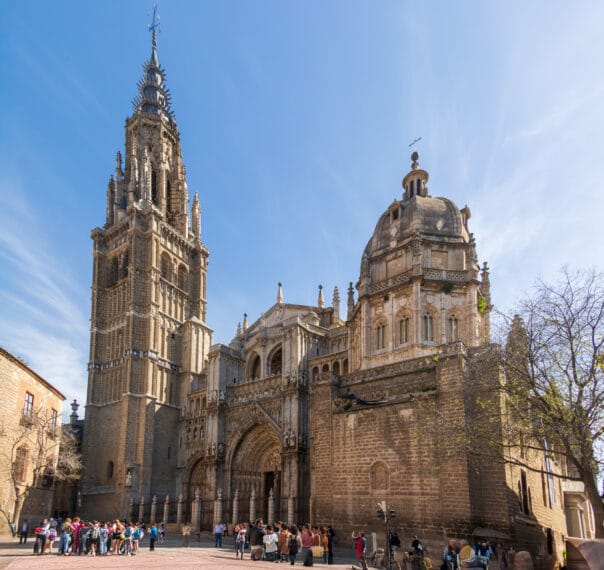After crossing the border from Romania into Ruse (Rousse), Bulgaria, I said goodbye to my Romanian guide and switched cars to meet my new Bulgarian driver/guide. Bulgaria often flies under the radar, yet it’s a fascinating country at the crossroads of Europe and Asia. It’s also an ideal destination for avoiding tourist crowds and staying on budget.

My travel buddy Ellen and I were soon riding into the countryside. Our guide explained that we were headed for a hidden marvel tucked in a quiet valley in northeastern Bulgaria—the Rusenski Lom River Valley. Our destination? The Rock-Hewn Churches of Ivanovo, a UNESCO World Heritage Site. He promised we’d see exquisite medieval frescoes carved into the walls and cliffs. They stand as artistic treasures that offer a rare glimpse into Bulgaria’s spiritual and cultural past.

Imagine my surprise when we pulled into the parking lot and found only one other car. At a World Heritage Site! Yes, it’s off the beaten track, but having it all to ourselves was a rare and wonderful treat. We started the climb up a series of staircases and worn paths, taking in the mountainous terrain around us. Eventually, we ducked into what looked like a narrow slit in the rock—and entered a cave.

Bulgaria’s Hidden Monastic Marvel
The churches and monasteries, carved directly into the cliffs, date from the 12th to 14th centuries. These sacred spaces were created by monks in search of solitude and are renowned for their remarkably well-preserved frescoes, especially those from the 14th century. These works reflect the Tarnovo School of Painting—a style I had never encountered before. Coincidentally, we were headed to Veliko Tarnovo next, the former historical and cultural capital of Bulgaria, often called the “City of the Tsars.”

These religious sites were not built in the traditional sense but hollowed out of solid rock by monks during the Second Bulgarian Empire. The complex once included over 40 churches and monastic cells, connected by paths and stairways along the rock face. Sadly, most are not preserved today.

A Brief History of the Rock-Hewn Churches
Since my visit, I’ve dug a little deeper and discovered these key historical highlights:
- Establishment: The complex was founded in the 1220s by Joachim I, the future Patriarch of Bulgaria, and expanded over the centuries.
- Monastic Life: Monks carved their cells, chapels, and churches directly into the limestone rock, creating a serene and spiritual environment.
- Religious Significance: By the 14th century, the site had become a major pilgrimage center and a hub of hesychasm, a mystical tradition in Eastern Orthodox Christianity focused on inner stillness and continuous prayer.
- Artistic Achievement: The frescoes—especially in five of the churches—are prime examples of Bulgarian medieval art.
- Decline and Ottoman Rule: The complex thrived during the Second Bulgarian Empire but declined under Ottoman rule, with some churches destroyed or abandoned.
- UNESCO World Heritage Status: Recognized in 1979 for its outstanding cultural value.

What I Saw
Inside, the frescoes often cover the ceilings and extend partially down the cave walls. (We didn’t venture to the lower levels, though they exist.) I was especially struck by a depiction of the Last Supper—painted more than a century before Leonardo da Vinci’s famous version. Some of the figures appear elongated; others resemble the stylized look of religious icons. While there was a bit of graffiti scratched into the plaster, I was relieved to see that most of the paintings remain in good shape.

The space itself is intimate. At times, I had to duck under the low ceilings. One chamber features a stone ledge that opens to the outside, letting in some natural light—just enough to highlight the details without modern intrusion.

Planning Your Visit to the Rock-Hewn Churches
Admission
We arrived in the late afternoon, and I’m not sure the visitor center was open. Apparently, there’s a small entrance fee—about $3.50 USD. Facilities include restrooms (with a nominal fee), a gift shop selling local crafts, and a small café offering regional dishes.

Location & Access
The Rock-Hewn Churches are located about 15 miles south of Ruse and roughly 80 miles from Veliko Tarnovo.
Visiting Hours
The site is open seasonally, from April through November, generally from 9:00 AM to 6:00 PM.
Ending Thoughts
This detour to the Ivanovo churches was more than just a side trip—it felt like stepping into a forgotten world. If you’re traveling in Bulgaria, don’t miss this remarkable window into the country’s medieval past. It may not be packed with tourists, but its beauty and historical depth speak volumes.







